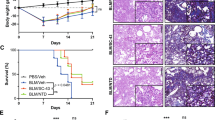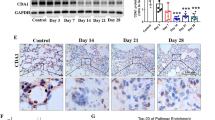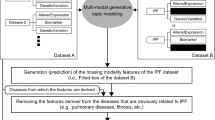Abstract
Idiopathic pulmonary fibrosis (IPF) is a chronic, progressive interstitial lung disease characterized by complex aetiologies involving the accumulation of inflammatory cells, such as macrophages, in the alveoli. This process is driven by uncontrolled extracellular matrix (ECM) deposition and the development of fibrous connective tissues. Here, we observed that the mRNA expression of Ffar1, the gene encoding G protein-coupled receptor 40 (GPR40), is repressed, while Cd36 is increased in the bronchoalveolar lavage fluid (BALF), which is predominantly composed of alveolar macrophages, of IPF patients. Furthermore, the GPR40 protein was found to be largely adhered to macrophages and was pathologically downregulated in the lungs of bleomycin (BLM)-induced PF model mice (PF mice) compared with those of control mice. Specific knockdown of GPR40 in pulmonary macrophages by adeno-associated virus 9-F4/80-shGPR40 (AAV9-shGPR40) exacerbated the fibrotic phenotype in the PF mice, and activation of GPR40 by its determined agonist compound SC (1,3-dihydroxy-8-methoxy-9H-xanthen-9-one) effectively protected the PF mice from pathological exacerbation. Moreover, Ffar1 or Cd36 gene knockout mouse-based assays were performed to explore the mechanism underlying the regulation of GPR40 activation in pulmonary macrophages with compound SC as a probe. We found that compound SC mitigated pulmonary fibrosis progression by preventing M2 macrophage polarization from exerting profibrotic effects through the GPR40/PKD1/CD36 axis. Our results strongly support the therapeutic potential of targeting intrinsic GPR40 activation in pulmonary macrophages for IPF and highlight the potential of compound SC in treating this disease.

This is a preview of subscription content, access via your institution
Access options
Subscribe to this journal
Receive 12 print issues and online access
$259.00 per year
only $21.58 per issue
Buy this article
- Purchase on SpringerLink
- Instant access to full article PDF
Prices may be subject to local taxes which are calculated during checkout







Similar content being viewed by others
References
Gao S, Li X, Jiang Q, Liang Q, Zhang F, Li S, et al. PKM2 promotes pulmonary fibrosis by stabilizing TGF-β1 receptor I and enhancing TGF-β1 signaling. Sci Adv. 2022;8:eabo0987.
Kao JH, Huang HT, Li KJ. Nintedanib in progressive fibrosing interstitial lung diseases. N Engl J Med. 2020;382:780–1.
Nasser M, Larrieu S, Si-Mohamed S, Ahmad K, Boussel L, Brevet M, et al. Progressive fibrosing interstitial lung disease: a clinical cohort (the PROGRESS study). Eur Respir J. 2021;57:2002718.
Green ID, Pinello N, Song R, Lee Q, Halstead James M, Kwok CT, et al. Macrophage development and activation involve coordinated intron retention in key inflammatory regulators. Nucleic Acids Res. 2020;48:6513–29.
Yue P, Zhou W, Huang G, Lei F, Chen Y, Ma Z, et al. Nanocrystals based pulmonary inhalation delivery system: advance and challenge. Drug Deliv. 2022;29:637–51.
Wynn TA, Vannella KM. Macrophages in tissue repair, regeneration, and fibrosis. Immunity. 2016;44:450–62.
Kishore A, Petrek M. Roles of macrophage polarization and macrophage-derived miRNAs in pulmonary fibrosis. Front Immunol. 2021;12:678457.
Buechler MB, Fu W, Turley SJ. Fibroblast-macrophage reciprocal interactions in health, fibrosis, and cancer. Immunity. 2021;54:903–15.
Tu B, Li J, Sun Z, Zhang T, Liu H, Yuan F, et al. Macrophage-derived TGF-β and VEGF promote the progression of trauma-induced heterotopic ossification. Inflammation. 2023;46:202–16.
Wang Y, Zhang L, Wu GR, Zhou Q, Yue HH, Rao LZ, et al. MBD2 serves as a viable target against pulmonary fibrosis by inhibiting macrophage M2 program. Sci Adv. 2021;7:eabb6075.
Kimura I, Ichimura A, Ohue-Kitano R, Igarashi M. Free fatty acid receptors in health and disease. Physiol Rev. 2020;100:171–210.
Burant CF. Activation of GPR40 as a therapeutic target for the tr eatment of type 2 diabetes. Diab Care. 2013;36 Suppl 2:S175–9.
Xu JW, Xu X, Ling Y, Wang YC, Huang YJ, Yang JZ, et al. Vincamine as an agonist of G-protein-coupled receptor 40 effectively ameliorates diabetic peripheral neuropathy in mice. Acta Pharmacol Sin. 2023;44:2388–403.
Liu C, Cheng ZY, Xia QP, Hu YH, Wang C, He L. GPR40 receptor agonist TAK-875 improves cognitive deficits and reduces β-amyloid production in APPswe/PS1dE9 mice. Psychopharmacology (Berl). 2021;238:2133–46.
Gagnon L, Leduc M, Thibodeau JF, Zhang MZ, Grouix B, Sarra-Bournet F, et al. A newly discovered antifibrotic pathway regulated by two fatty acid receptors: GPR40 and GPR84. Am J Pathol. 2018;188:1132–48.
Li MH, Chen W, Wang LL, Sun JL, Zhou L, Shi YC, et al. RLA8-A new and highly effective quadruple PPAR-α/γ/δ and GPR40 agonist to reverse nonalcoholic steatohepatitis and fibrosis. J Pharmacol Exp Ther. 2019;369:67–77.
Grouix B, Sarra-Bournet F, Leduc M, Simard JC, Hince K, Geerts L, et al. PBI-4050 reduces stellate cell activation and liver fibrosis through modulation of intracellular ATP levels and the liver kinase B1/AMP-activated protein kinase/mammalian target of rapamycin pathway. J Pharmacol Exp Ther. 2018;367:71–81.
Khalil N, Manganas H, Ryerson CJ, Shapera S, Cantin AM, Hernandez P, et al. Phase 2 clinical trial of PBI-4050 in patients with idiopathic pulmonary fibrosis. Eur Respir J. 2019;53:1800663.
Zhao T, Zhou Z, Zhao S, Wan H, Li H, Hou J, et al. Vincamine as an agonist of G protein-coupled receptor 40 effectively ameliorates pulmonary fibrosis in mice. Phytomedicine. 2023;118:154919.
Chang J-K, Ni Y, Han L, Sinnett-Smith J, Jacamo R, Rey O, et al. Protein kinase D1 (PKD1) phosphorylation on Ser203 by type I p21-activated kinase (PAK) regulates PKD1 localization. J Biol Chem. 2017;292:9523–39.
Asaithambi A, Ay M, Jin H, Gosh A, Anantharam V, Kanthasamy A, et al. Protein kinase D1 (PKD1) phosphorylation promotes dopaminergic neuronal survival during 6-OHDA-induced oxidative stress. PLoS One. 2014;9:e96947.
Ferdaoussi M, Bergeron V, Zarrouki B, Kolic J, Cantley J, Fielitz J, et al. G protein-coupled receptor (GPR) 40-dependent potentiation of insulin secretion in mouse islets is mediated by protein kinase D1. Diabetologia. 2012;55:2682–92.
Tan M, Xu X, Ohba M, Ogawa W, Cui MZ. Thrombin rapidly induces protein kinase D phosphorylation, and protein kinase C delta mediates the activation. J Biol Chem. 2003;278:2824–8.
Ren B, Hale J, Srikanthan S, Silverstein RL. Lysophosphatidic acid suppresses endothelial cell CD36 expression and promotes angiogenesis via a PKD-1-dependent signaling pathway. Blood. 2011;117:6036–45.
Yang X, Okamura DM, Lu X, Chen Y, Moorhead J, Varghese Z, et al. CD36 in chronic kidney disease: novel insights and therapeutic opportunities. Nat Rev Nephrol. 2017;13:769–81.
Hou Y, Wu M, Wei J, Ren Y, Du C, Wu H, et al. CD36 is involved in high glucose-induced epithelial to mesenchymal transition in renal tubular epithelial cells. Biochem Biophys Res Commun. 2015;468:281–6.
Silverstein RL, Febbraio M. CD36, a scavenger receptor involved in immunity, metabolism, angiogenesis, and behavior. Sci Signal. 2009;2: re3.
Chu LY, Ramakrishnan DP, Silverstein RL. Thrombospondin-1 modulates VEGF signaling via CD36 by recruiting SHP-1 to VEGFR2 complex in microvascular endothelial cells. Blood. 2013;122:1822–32.
Chen Y, Wang X, Weng D, Tao S, Lv L, Chen J. A TSP-1 functional fragment inhibits activation of latent transforming growth factor-beta1 derived from rat alveolar macrophage after bleomycin treatment. Exp Toxicol Pathol. 2009;61:67–73.
Wang X, Chen Y, Lv L, Chen J. Silencing CD36 gene expression results in the inhibition of latent-TGF-beta1 activation and suppression of silica-induced lung fibrosis in the rat. Respir Res. 2009;10:36.
Suzuki O, Katsumata Y, Oya M, Chari VM, Vermes B, Wagner H, et al. Inhibition of type A and type B monoamine oxidases by naturally occurring xanthones. Planta Med. 1981;42:17–21.
Huang Q, Wang Y, Wu H, Yuan M, Zheng C, Xu H. Xanthone glucosides: isolation, bioactivity and synthesis. Molecules. 2021;26:5575.
Hogea SP, Tudorache E, Pescaru C, Marc M, Oancea C. Bronchoalveolar lavage: role in the evaluation of pulmonary interstitial disease. Expert Rev Respir Med. 2020;14:1117–30.
Van Dyken SJ, Locksley RM. Interleukin-4- and interleukin-13-mediated alternatively activated macrophages: roles in homeostasis and disease. Annu Rev Immunol. 2013;31:317–43.
Li Q, Cheng Y, Zhang Z, Bi Z, Ma X, Wei Y, et al. Inhibition of ROCK ameliorates pulmonary fibrosis by suppressing M2 macrophage polarisation through phosphorylation of STAT3. Clin Transl Med. 2022;12:e1036.
Mecozzi L, Mambrini M, Ruscitti F, Ferrini E, Ciccimarra R, Ravanetti F, et al. In-vivo lung fibrosis staging in a bleomycin-mouse model: a new micro-CT guided densitometric approach. Sci Rep. 2020;10:18735.
Park J, Jung J, Yoon SH, Hong H, Kim H, Kim H, et al. CT quantification of the heterogeneity of fibrosis boundaries in idiopathic pulmonary fibrosis. Eur Radio. 2021;31:5148–59.
Thiesse J, Namati E, Sieren JC, Smith AR, Reinhardt JM, Hoffman EA, et al. Lung structure phenotype variation in inbred mouse strains revealed through in vivo micro-CT imaging. J Appl Physiol (1985). 2010;109:1960–8.
Tian Y, Lv J, Su Z, Wu T, Li X, Hu X, et al. LRRK2 plays essential roles in maintaining lung homeostasis and preventing the development of pulmonary fibrosis. Proc Natl Acad Sci USA. 2021;118:e2106685118.
Hou T, Cao Z, Zhang J, Tang M, Tian Y, Li Y, et al. SIRT6 coordinates with CHD4 to promote chromatin relaxation and DNA repair. Nucleic Acids Res. 2020;48:2982–3000.
Raghu G, Remy-Jardin M, Richeldi L, Thomson CC, Inoue Y, Johkoh T, et al. Idiopathic pulmonary fibrosis (an Update) and progressive pulmonary fibrosis in adults: An Official ATS/ERS/JRS/ALAT Clinical Practice Guideline. Am J Respir Crit Care Med. 2022;205:e18–e47.
Meyer KC, Raghu G, Baughman RP, Brown KK, Costabel U, du, Bois RM, et al. An official american thoracic society clinical practice guideline: the clinical utility of bronchoalveolar lavage cellular analysis in interstitial lung disease. Am J Respir Crit Care Med. 2012;185:1004–14.
Cecchini MJ, Hosein K, Howlett CJ, Joseph M, Mura M. Comprehensive gene expression profiling identifies distinct and overlapping transcriptional profiles in non-specific interstitial pneumonia and idiopathic pulmonary fibrosis. Respir Res. 2018;19:153.
Du T, Yang L, Xu X, Shi X, Xu X, Lu J, et al. Vincamine as a GPR40 agonist improves glucose homeostasis in type 2 diabetic mice. J Endocrinol. 2019;240:195–214.
Suski M, Kiepura A, Wiśniewska A, Kuś K, Skałkowska A, Stachyra K, et al. Anti-atherosclerotic action of GW9508 - free fatty acid receptors activator - in apoE-knockout mice. Pharmacol Rep. 2019;71:551–5.
Deng MY, Ahmad KA, Han QQ, Wang ZY, Shoaib RM, Li XY, et al. Thalidomide alleviates neuropathic pain through microglial IL-10/β-endorphin signaling pathway. Biochem Pharmacol. 2021;192:114727.
Umehara T, Winstanley YE, Andreas E, Morimoto A, Williams EJ, Smith KM, et al. Female reproductive life span is extended by targeted removal of fibrotic collagen from the mouse ovary. Sci Adv. 2022;8:eabn4564.
Kim DW, Jo YY, Garagiola U, Choi JY, Kang YJ, Oh JH, et al. Increased level of vascular endothelial growth factors by 4-hexylresorcinol is mediated by transforming growth factor-β1 and accelerates capillary regeneration in the burns in diabetic animals. Int J Mol Sci. 2020;21:3473.
Guan R, Yuan L, Li J, Wang J, Li Z, Cai Z, et al. Bone morphogenetic protein 4 inhibits pulmonary fibrosis by modulating cellular senescence and mitophagy in lung fibroblasts. Eur Respir J. 2022;60:2102307.
Khalil N. Post translational activation of latent transforming growth factor beta (L-TGF-beta): clinical implications. Histol Histopathol. 2001;16:541–51.
Ye Z, Hu Y. TGF‑β1: Gentlemanly orchestrator in idiopathic pulmonary fibrosis (Review). Int J Mol Med. 2021;48:132.
Silverstein RL, Febbraio M. CD36, a scavenger receptor involved in immunity, metabolism, angiogenesis, and behavior. Sci Signal. 2009;2:re3.
Ren B, Best B, Ramakrishnan DP, Walcott BP, Storz P, Silverstein RL. LPA/PKD-1-FoxO1 signaling axis mediates endothelial cell CD36 transcriptional repression and proangiogenic and proarteriogenic reprogramming. Arterioscler Thromb Vasc Biol. 2016;36:1197–208.
Cho JH, Gelinas R, Wang K, Etheridge A, Piper MG, Batte K, et al. Systems biology of interstitial lung diseases: integration of mRNA and microRNA expression changes. BMC Med Genomics. 2011;4:8.
Prasse A, Binder H, Schupp JC, Kayser G, Bargagli E, Jaeger B, et al. BAL cell gene expression is indicative of outcome and airway basal cell involvement in idiopathic pulmonary fibrosis. Am J Respir Crit Care Med. 2019;199:622–30.
Shi Y, Gochuico BR, Yu G, Tang X, Osorio JC, Fernandez IE, et al. Syndecan-2 exerts antifibrotic effects by promoting caveolin-1-mediated transforming growth factor-β receptor I internalization and inhibiting transforming growth factor-β1 signaling. Am J Respir Crit Care Med. 2013;188:831–41.
Venardos K, De Jong KA, Elkamie M, Connor T, McGee SL. The PKD inhibitor CID755673 enhances cardiac function in diabetic db/db mice. PLoS One. 2015;10:e0120934.
Thorn R, Hemmingsson O, Danielsson Borssen A, Werner M, Karling P, Wixner J. Improved survival in at-risk patients undergoing surveillance for hepatocellular carcinoma - a nationwide swedish register-based study. J Hepatocell Carcinoma. 2023;10:1573–86.
Rumende CM, Susanto EC, Sitorus TP. The Management of pulmonary fibrosis in COVID-19. Acta Med Indones. 2021;53:233–41.
Cherrez-Ojeda I, Cortes-Telles A, Gochicoa-Rangel L, Camacho-Leon G, Mautong H, Robles-Velasco K, et al. Challenges in the management of post-COVID-19 pulmonary fibrosis for the latin American population. J Pers Med. 2022;12:1393.
Adams TS, Schupp JC, Poli S, Ayaub EA, Neumark N, Ahangari F, et al. Single-cell RNA-seq reveals ectopic and aberrant lung-resident cell populations in idiopathic pulmonary fibrosis. Sci Adv. 2020;6:eaba1983.
Wang L, Sun L, Gu Z, Li W, Guo L, Ma S, et al. N-carboxymethyl chitosan/sodium alginate composite hydrogel loading plasmid DNA as a promising gene activated matrix for in-situ burn wound treatment. Bioact Mater. 2022;15:330–42.
Wang H, Yu H, Huang T, Wang B, Xiang L. Hippo-YAP/TAZ signaling in osteogenesis and macrophage polarization: Therapeutic implications in bone defect repair. Genes Dis. 2023;10:2528–39.
Zhao Y, Yu Y, Wang S, Li J, Teng L. Small extracellular vesicles encapsulating lefty1 mRNA inhibit hepatic fibrosis. Asian J Pharm Sci. 2022;17:630–40.
Hinz B. Mechanical aspects of lung fibrosis: a spotlight on the myofibroblast. Proc Am Thorac Soc. 2012;9:137–47.
Krishna SM, Golledge J. The role of thrombospondin-1 in cardiovascular health and pathology. Int J Cardiol. 2013;168:692–706.
Ferdaoussi M, Bergeron V, Zarrouki B, Kolic J, Cantley J, Fielitz J, et al. G protein-coupled receptor (GPR)40-dependent potentiation of insulin secretion in mouse islets is mediated by protein kinase D1. Diabetologia. 2012;55:2682–92.
Sacks D, Baxter B, Campbell BCV, Carpenter JS, Cognard C, Dippel D, et al. Multisociety consensus quality improvement revised consensus statement for endovascular therapy of acute ischemic stroke. Int J Stroke. 2018;13:612–32.
Chen HY, Plummer CW, Xiao D, Chobanian HR, DeMong D, Miller M, et al. Structure-activity relationship of novel and selective biaryl-chroman GPR40 AgoPAMs. ACS Med Chem Lett. 2018;9:685–90.
Nishizaki H, Matsuoka O, Kagawa T, Kobayashi A, Watanabe M, Moritoh Y. SCO-267, a GPR40 full agonist, stimulates islet and gut hormone secretion and improves glycemic control in humans. Diabetes. 2021;70:2364–76.
Mach M, Bazydło-Guzenda K, Buda P, Matłoka M, Dzida R, Stelmach F, et al. Discovery and development of CPL207280 as new GPR40/FFA1 agonist. Eur J Med Chem. 2021;226:113810.
Chda A, Bencheikh R. Flavonoids as G protein-coupled receptors ligands: new potential therapeutic natural drugs. Curr Drug Targets. 2023;24:1346–63.
Zhu W, Liu C, Tan C, Zhang J. Predictive biomarkers of disease progression in idiopathic pulmonary fibrosis. Heliyon. 2024;10:e23543.
Sharlow ER, Giridhar KV, LaValle CR, Chen J, Leimgruber S, Barrett R, et al. Potent and selective disruption of protein kinase D functionality by a benzoxoloazepinolone. J Biol Chem. 2008;283:33516–26.
Acknowledgements
This work was supported by the National Natural Science Foundation of China (82204486, 82304468), the Natural Science Foundation for Young Scientists of Nanjing University of Chinese Medicine (XPT82204486, XPT82304468), and the Major Program of the Natural Science Foundation of the Jiangsu Higher Education Institutions of China (24KJA310006).
Author information
Authors and Affiliations
Contributions
HQW: Investigation, Formal analysis, Validation, Methodology, Writing-original draft. LFX: Investigation, Methodology, Validation. HLL: Methodology, Validation. YM: Methodology, Validation. QHL: Investigation, Methodology. MQD: Investigation, Methodology. YDF: Resources, Formal analysis. WJL: Funding acquisition. JPZ: Conceptualization, Formal analysis. MYQ: Conceptualization, Data curation, Writing-review & editing, Funding acquisition. XS: Conceptualization, Writing-review & editing, Project administration, Funding acquisition.
Corresponding authors
Ethics declarations
Competing interests
The authors declare no competing interests.
Additional information
Publisher’s note Springer Nature remains neutral with regard to jurisdictional claims in published maps and institutional affiliations.
Supplementary information
Rights and permissions
Springer Nature or its licensor (e.g. a society or other partner) holds exclusive rights to this article under a publishing agreement with the author(s) or other rightsholder(s); author self-archiving of the accepted manuscript version of this article is solely governed by the terms of such publishing agreement and applicable law.
About this article
Cite this article
Wan, Hq., Xie, Lf., Li, Hl. et al. GPR40 activation alleviates pulmonary fibrosis by repressing M2 macrophage polarization through the PKD1/CD36/TGF-β1 pathway. Acta Pharmacol Sin 46, 2707–2722 (2025). https://doi.org/10.1038/s41401-025-01558-y
Received:
Accepted:
Published:
Issue date:
DOI: https://doi.org/10.1038/s41401-025-01558-y



